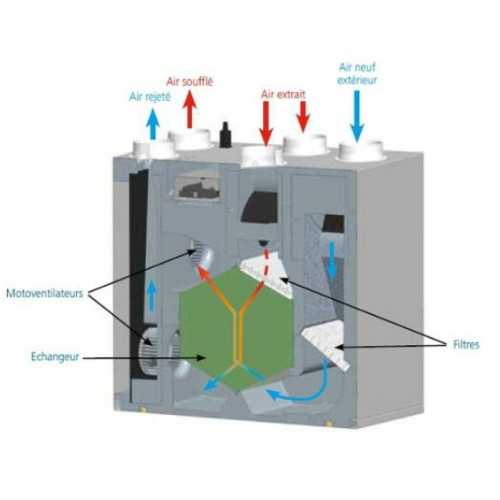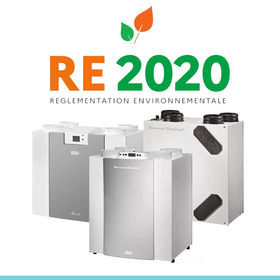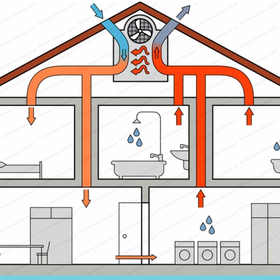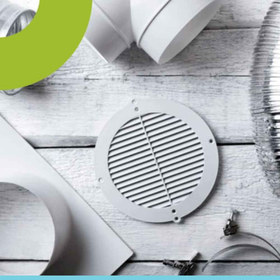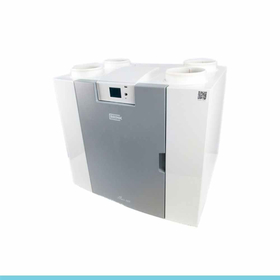Everything you need to know about double-flow ventilation
To have a healthy home, good ventilation is of paramount importance. Even if occupants already use natural ventilation, this classic solution is not enough to improve air quality.
To bring fresh air into a home, the use of VMC or controlled mechanical ventilation is necessary. This need is today reinforced by the level of insulation of housing which is improving.
Unlike the single-flow installation, the double-flow installation provides several advantages. Discover the important points to know about the system in this article.
How does a double-flow VMC work?
A double-flow VMC is a ventilation system which captures fresh air through an external air intake and then passes it through a heat exchanger. The purpose of the exchanger is to recover part of the calories before rejecting them.
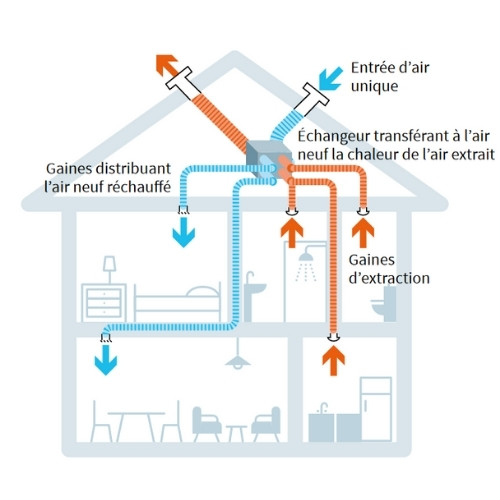
Source: Ademe
The air is then distributed into the different rooms through a network of ducts (also called ducts). To be precise, there are two duct networks, each of which is equipped with an electric fan. The first is used to breathe fresh air into the busiest rooms. The second allows polluted air to be extracted from utility or humid rooms (toilet, bathroom, kitchen).
Thanks to these components, the double-flow VMC ensures the extraction of stale air and the supply of new air into the house. That's not all, it filters the incoming air and preheats it in the event of a drop in outside temperature.
Composition of a double flow vmc central unit
A complete system is made up of different components grouped within this central unit:
- An exchanger
- A return fan: it sucks in the stale air to filter it and send it to the exchanger
- Filters for pollen and dust
- A blower fan: it will diffuse fresh air into the house
- a static energy harvester (plate or rotary)
- For thermodynamic vmc, a heat pump
- Depending on the model, a bypass: it allows a flow to be diverted in order to avoid the exchanger
- Defrosting: electric resistance or hot water radiator to protect the exchanger which cannot withstand negative temperatures
Source: instrumentation notebooks
Advantages of a double-flow VMC
Air quality
In terms of indoor air quality (IAQ), dual-flow ventilation distributes a flow of fresh air to the different spaces in your home. The installation and network must obviously be of high quality and maintained to avoid leaks.
The presence of different filters also blocks some of the pollen and dust.
Comfort
Double-flow VMC plays a role in three elements of comfort: thermal comfort, acoustic comfort (with a network installed according to the rules of the art ) and olfactory comfort (smells).
On the first point, the thermal aspect, the double-flow allows the air in the exchanger to be preheated in winter or conversely, cooled in summer thanks to over-ventilation or by combining it with a Canadian well or Provencal. In addition, by ensuring regular air renewal, you do not need to create drafts.
On the audio levelIf necessary, the arrival of external noise will be limited: no direct passage from the outside to the inside. Be careful to respect a silent diffusion of air within the different rooms.
And last point, in terms of odor, ventilation ensures more regular air renewal throughout your home.
Energy performance
By recovering calories from the outside, your ventilation significantly improves this performance. This is why we find these installations in positive energy houses or passive houses.
Developments in the types of exchangers now make it possible to target an efficiency of more than 90%. Concretely, this means that if it is 0° outside and 20° inside, the fresh air at the outlet of the exchanger will be 20 x 90% or 18°. With a simple flow, the air will arrive directly without being heated. The volumes of air renewed can therefore be significant for very low heat loss.
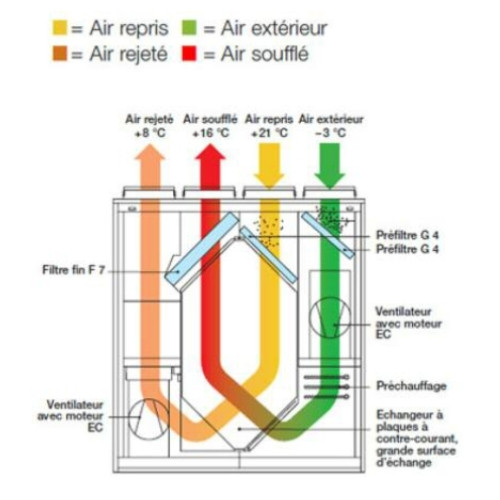
Achieving good energy performance also requires a well-designed installation and good maintenance of your VMC.
Note that a double-flow VMC, coupled with a Canadian well , allows you to naturally cool your home. This will allow you to make significant electricity savings compared to using air conditioning.
What are the disadvantages of a double-flow VMC?
Despite its many advantages, there are some disadvantages. The system consumes energy continuously. Even if the level of consumption remains low, it is recommended to maintain a minimum of ventilation throughout the day. Please pay particular attention to the energy data indicated on the NF or PHI certificates.
Apart from that, the double flow VMC requires regular maintenance . Filters should be changed at least twice a year to maintain engine performance. Its installation is not recommended for renovation. The operation can be delicate and complex. It is more suitable for new buildings.
In addition, its assembly can cause a congestion problem. This equipment requires a dedicated space in a heated part of the house.
When it comes to comfort, poor installation potentially generates noise pollution, particularly in the air vents.
What are the differences with a single flow VMC?
Single or dual-flow, any VMC assumes the same functions. Each system is designed to provide a healthy environment in the home. However, dual-flow technology can recover up to 70 or even 90% of the calories from the air exhausted from the house.
This heat subsequently allows the incoming air directed into the main rooms to be preheated. It is the heat exchanger which ensures the reuse of heat from the extracted air and its transmission to the fresh air.
Find our special article on the differences between a single and double flow
Another notable advantage, the mission of the dual-flow system does not only apply to guaranteeing the entry of fresh air. It also allows polluted air to escape. On the other hand, the role of the single flow installation is limited to the evacuation of stale air from a house. Thanks to this big difference, it is normal that the first option costs a little expensive.
What is the price of a double-flow VMC?
Taking into account its performance, dual-flow VMC represents a significant investment. With installation included, it generally costs €3,000 to €8,000. The figure can vary depending on many parameters, namely the size of the house to be ventilated, the model of the equipment, the brand and the complexity of assembly. As part of the renovation, the installation potentially seems more expensive.
Material price
If you opt for classic double-flow VMC, plan on spending between €1,500 to €5,000.
As for the more advanced system, the price increases depending on its power. On average, the acquisition of thermodynamic double-flow VMC supplies requires a budget between €4,000 to €11,000.
Installation price
As mentioned above, installing the system is more complicated in renovation. To this end, it is logical that the price increases according to the constraints encountered.
To avoid unforeseen events, it is recommended to prepare between 5,500 to 8,000 euros. For thermodynamic double flow VMC, installation and delivery cost up to 15,000 euros.
What savings can be made with a dual-flow VMC?
Double-flow VMC offers very significant efficiency in terms of air conditioning or heating. The integrated heat exchanger allows calories to be transmitted from the extracted air to the sucked-in air.
With a quality model, you can keep 85% to 95% of the heat, helping you reduce energy costs. With each annual bill, ventilation saves you up to 230 euros per year on your energy costs.
How is a double flow VMC installed?
Its location requires significant space for all the equipment. They must be easily accessible to simplify their maintenance.
Technicians often install the heat exchanger in the attic due to its large size. For fans and ducts, their installation depends on the surface to be ventilated and the regulatory constraints determining the required air flow rates. You can put the insufflation and extraction ducts under a false ceiling or in the attic.
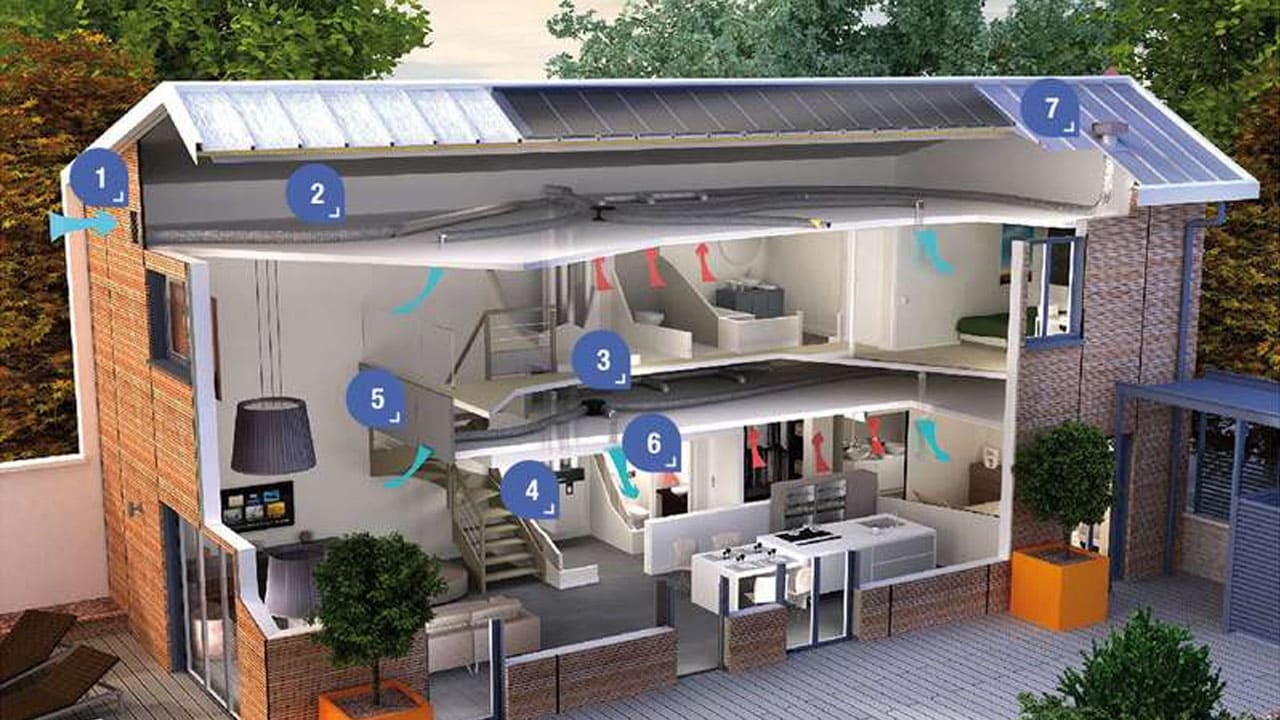
Source: aldes benelux
- Exterior grille: Fresh air intake, wall positioning.
- Ducts: The ducts ( ducts ) connect the extraction vents and the supply vents to the air purification group.
- Distribution box: allows the air blown into the home to be distributed evenly.
- Double flow ventilation solution: Equipped with an exchanger, which recovers the calories from the extracted air and a motor which ensures the insufflation of fresh air and the extraction of stale air, while limiting the energy consumption.
- Diffusion grilles: Diffuse the air in the bedrooms and living room, can be installed on the wall or ceiling. The air jet can be directed for greater comfort.
- Extraction vents: extract the air in the sanitary facilities (bathroom and toilet) and the kitchen. They can be self-adjusting (constant air flow), or hygro-adjustable (air flow depending on the humidity of the room).
- Roof outlet: Rejection of stale air from the roof.
To avoid making any mistakes, it may be wise to contact a professional. Installation requires technical knowledge between the evaluation of sizing and the regulatory standards to follow. We support dozens of customers every month to make the right choice.
Our opinion
Given its multiple advantages, dual-flow VMC constitutes a profitable investment. Thanks to its ingenious system, it guarantees better air quality while limiting heat loss.
Despite its energy consumption, the yields obtained are appreciable. It is now essential in achieving the objectives of the new RT2020 requirements. Whether you are undertaking a renovation or simple work, VMC is an element of comfort that is often neglected even though it is the air that we breathe throughout our day!
In addition to changing the windows, for example, also consider changing your old ventilation. Many solutions exist, both for new and old buildings, particularly for the smallest spaces (such as false ceilings in particular).
Contact us to benefit from advice from our team. To finance your investment, aid such as MaPrimeRenov allows the State to cover part of the cost.
No posts found
Write a review
